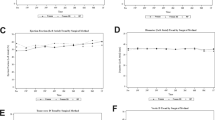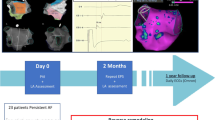Abstract
We evaluated the effects of adjunctive left anterior line (LAL) ablation on LA dyssynchrony and function using real-time three-dimensional echocardiography (3DE) in connection with thromboembolic complications and tachyarrhythmia recurrence in patients with persistent atrial fibrillation (AF). We randomly and prospectively assigned consecutive persistent AF patients to the LAL (n = 52, 65 ± 7 years) and control groups (n = 50, 64 ± 10 years). In the LAL group, extensive encircling pulmonary vein isolation (EEPVI), roof line ablation, and LAL ablation regardless of the extent of the low-voltage area (LVA) were performed. The control group underwent EEPVI and roof line ablation. After ablation, 3DE demonstrated LA dyssynchrony in 23 (46%) and 4 patients (8%, P < 0.001) of the LAL and control groups, respectively. Baseline LA LVAs were relatively small in most patients and there were no significant differences in extent of LVA between control and LAL groups or between patients with and without dyssynchrony. During the follow-up periods (771 ± 121 days), patients with LA dyssynchrony in the LAL group did not show significant differences in symptomatic thromboembolic events (0%) and atrial tachyarrhythmia recurrence (39%) from patients without LA dyssynchrony in the LAL (0% and 30%) and control groups (0% and 32%, respectively). LA ejection fraction and active emptying fraction were lower by 9% on average in the LAL group than in the control group (P < 0.0001). Similarly, in the LAL group, LA ejection fraction, active emptying fraction, and expansion index were significantly lower by approximately 7%, 8%, and 15%, respectively, in LA with dyssynchrony than those in LA without dyssynchrony. In conclusion, LA dyssynchrony and LA hypofunction were induced by LAL ablation in patients with persistent AF and relatively mild LVA. LAL ablation with or without LA dyssynchrony is thought not to affect thromboembolic complications or atrial tachyarrhythmia recurrence.





Similar content being viewed by others
References
Jiang Z, Yin H, He Y, Ma N, Tang M, Liu H, Ding F, Mei J (2015) Efficacy and safety of novel epicardial circumferential left atrial ablation with pulmonary vein isolation in sustained atrial fibrillation. Heart Vessels 30:675–681
Haissaguerre M, Hocini M, Sanders P, Sacher F, Rotter M, Takahashi Y, Rostock T, Hsu LF, Bordachar P, Reuter S, Roudaut R, Clementy J, Jais P (2005) Catheter ablation of long-lasting persistent atrial fibrillation: clinical outcome and mechanisms of subsequent arrhythmias. J Cardiovasc Electrophysiol 16:1138–1147
Tzeis S, Luik A, Jilek C, Schmitt C, Estner HL, Wu J, Reents T, Fichtner S, Kolb C, Karch MR, Hessling G, Deisenhofer I (2010) The modified anterior line: an alternative linear lesion in perimitral flutter. J Cardiovasc Electrophysiol 21:665–670
Ammar S, Luik A, Hessling G, Bruhm A, Reents T, Semmler V, Buiatti A, Kathan S, Hofmann M, Kolb C, Schmitt C, Deisenhofer I (2015) Ablation of perimitral flutter: acute and long-term success of the modified anterior line. Europace 17:447–452
(2000) World Medical Association Declaration of Helsinki: ethical principles for medical research involving human subjects. JAMA 284:3043–3045
Yamaji H, Murakami T, Hina K, Higashiya S, Kawamura H, Murakami M, Kamikawa S, Komtasubara I, Kusachi S (2016) Adequate initial heparin dosage for atrial fibrillation ablation in patients receiving non-vitamin K antagonist oral anticoagulants. Clin Drug Investig 36:837–848
Yamaji H, Murakami T, Hina K, Higashiya S, Kawamura H, Murakami M, Kamikawa S, Hirohata S, Kusachi S (2013) Usefulness of dabigatran etexilate as periprocedural anticoagulation therapy for atrial fibrillation ablation. Clin Drug Investig 33:409–418
Piorkowski C, Eitel C, Rolf S, Bode K, Sommer P, Gaspar T, Kircher S, Wetzel U, Parwani AS, Boldt LH, Mende M, Bollmann A, Husser D, Dagres N, Esato M, Arya A, Haverkamp W, Hindricks G (2011) Steerable versus nonsteerable sheath technology in atrial fibrillation ablation: a prospective, randomized study. Circ Arrhythm Electrophysiol 4:157–165
Lang RM, Bierig M, Devereux RB, Flachskampf FA, Foster E, Pellikka PA, Picard MH, Roman MJ, Seward J, Shanewise JS, Solomon SD, Spencer KT, Sutton MS, Stewart WJ (2005) Recommendations for chamber quantification: a report from the American Society of Echocardiography’s Guidelines and Standards Committee and the Chamber Quantification Writing Group, developed in conjunction with the European Association of Echocardiography, a branch of the European Society of Cardiology. J Am Soc Echocardiogr 18:1440–1463
Marsan NA, Tops LF, Holman ER, Van de Veire NR, Zeppenfeld K, Boersma E, van der Wall EE, Schalij MJ, Bax JJ (2008) Comparison of left atrial volumes and function by real-time three-dimensional echocardiography in patients having catheter ablation for atrial fibrillation with persistence of sinus rhythm versus recurrent atrial fibrillation three months later. Am J Cardiol 102:847–853
Murata M, Iwanaga S, Tamura Y, Kondo M, Kouyama K, Ogawa S (2008) A real-time three-dimensional echocardiographic quantitative analysis of left atrial function in left ventricular diastolic dysfunction. Am J Cardiol 102:1097–1102
Aune E, Baekkevar M, Roislien J, Rodevand O, Otterstad JE (2009) Normal reference ranges for left and right atrial volume indexes and ejection fractions obtained with real-time three-dimensional echocardiography. Eur J Echocardiogr 10:738–744
Lang RM, Badano LP, Mor-Avi V, Afilalo J, Armstrong A, Ernande L, Flachskampf FA, Foster E, Goldstein SA, Kuznetsova T, Lancellotti P, Muraru D, Picard MH, Rietzschel ER, Rudski L, Spencer KT, Tsang W, Voigt JU (2015) Recommendations for cardiac chamber quantification by echocardiography in adults: an update from the American Society of Echocardiography and the European Association of Cardiovascular Imaging. Eur Heart J Cardiovasc Imaging 16:233–270
Anwar AM, Soliman OI, Geleijnse ML, Nemes A, Vletter WB, ten Cate FJ (2008) Assessment of left atrial volume and function by real-time three-dimensional echocardiography. Int J Cardiol 123:155–161
Schwartzman D, Ren JF, Devine WA, Callans DJ (2001) Cardiac swelling associated with linear radiofrequency ablation in the atrium. J Interv Card Electrophysiol 5:159–166
Okada T, Yamada T, Murakami Y, Yoshida N, Ninomiya Y, Shimizu T, Toyama J, Yoshida Y, Ito T, Tsuboi N, Kondo T, Inden Y, Hirai M, Murohara T (2007) Prevalence and severity of left atrial edema detected by electron beam tomography early after pulmonary vein ablation. J Am Coll Cardiol 49:1436–1442
Verma N, Knight BP (2017) What happens during the blanking period does not stay in the blanking period. J Cardiovasc Electrophysiol 28:634–635
Alipour P, Azizi Z, Pirbaglou M, Ritvo P, Pantano A, Verma A, Khaykin Y (2017) Defining blanking period post pulmonary vein antrum isolation. JACC Clin Electrophysiol 3:568–576
Jenkins C, Bricknell K, Chan J, Hanekom L, Marwick TH (2007) Comparison of two- and three-dimensional echocardiography with sequential magnetic resonance imaging for evaluating left ventricular volume and ejection fraction over time in patients with healed myocardial infarction. Am J Cardiol 99:300–306
Grimm RA, Stewart WJ, Arheart K, Thomas JD, Klein AL (1997) Left atrial appendage “stunning” after electrical cardioversion of atrial flutter: an attenuated response compared with atrial fibrillation as the mechanism for lower susceptibility to thromboembolic events. J Am Coll Cardiol 29:582–589
Ellis K, Ziada KM, Vivekananthan D, Latif AA, Shaaraoui M, Martin D, Grimm RA (2006) Transthoracic echocardiographic predictors of left atrial appendage thrombus. Am J Cardiol 97:421–425
Santiago D, Warshofsky M, Li Mandri G, Di Tullio M, Coromilas J, Reiffel J, Homma S (1994) Left atrial appendage function and thrombus formation in atrial fibrillation-flutter: a transesophageal echocardiographic study. J Am Coll Cardiol 24:159–164
Weerasooriya R, Khairy P, Litalien J, Macle L, Hocini M, Sacher F, Lellouche N, Knecht S, Wright M, Nault I, Miyazaki S, Scavee C, Clementy J, Haissaguerre M, Jais P (2011) Catheter ablation for atrial fibrillation: are results maintained at 5 years of follow-up? J Am Coll Cardiol 57:160–166
Verma A, Jiang CY, Betts TR, Chen J, Deisenhofer I, Mantovan R, Macle L, Morillo CA, Haverkamp W, Weerasooriya R, Albenque JP, Nardi S, Menardi E, Novak P, Sanders P (2015) Approaches to catheter ablation for persistent atrial fibrillation. N Engl J Med 372:1812–1822
Wong KC, Paisey JR, Sopher M, Balasubramaniam R, Jones M, Qureshi N, Hayes CR, Ginks MR, Rajappan K, Bashir Y, Betts TR (2015) No benefit of complex fractionated atrial electrogram ablation in addition to circumferential pulmonary vein ablation and linear ablation: benefit of complex ablation study. Circ Arrhythm Electrophysiol 8:1316–1324
Rolf S, Kircher S, Arya A, Eitel C, Sommer P, Richter S, Gaspar T, Bollmann A, Altmann D, Piedra C, Hindricks G, Piorkowski C (2014) Tailored atrial substrate modification based on low-voltage areas in catheter ablation of atrial fibrillation. Circ Arrhythm Electrophysiol 7:825–833
Jadidi AS, Lehrmann H, Keyl C, Sorrel J, Markstein V, Minners J, Park CI, Denis A, Jais P, Hocini M, Potocnik C, Allgeier J, Hochholzer W, Herrera-Sidloky C, Kim S, Omri YE, Neumann FJ, Weber R, Haissaguerre M, Arentz T (2016) Ablation of persistent atrial fibrillation targeting low-voltage areas with selective activation characteristics. Circ Arrhythm Electrophysiol 9:e002962
Yagishita A, Gimbel JR, De Oliveira S, Manyam H, Sparano D, Cakulev I, Mackall J, Arruda M (2017) Long-term outcome of left atrial voltage-guided substrate ablation during atrial fibrillation: a novel adjunctive ablation strategy. J Cardiovasc Electrophysiol 28:147–155
Author information
Authors and Affiliations
Corresponding author
Ethics declarations
Conflict of interest
All authors declare that they have no competing interests.
Electronic supplementary material
Below is the link to the electronic supplementary material.
Rights and permissions
About this article
Cite this article
Yamaji, H., Murakami, T., Hina, K. et al. Adjunctive left anterior line ablation induced left atrial dysfunction and dyssynchrony in atrial fibrillation ablation. Heart Vessels 34, 331–342 (2019). https://doi.org/10.1007/s00380-018-1238-x
Received:
Accepted:
Published:
Issue Date:
DOI: https://doi.org/10.1007/s00380-018-1238-x




